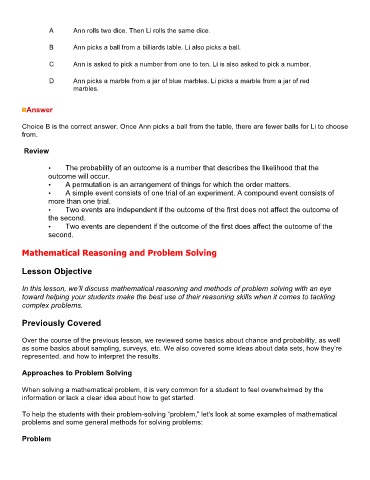Page 286 - ABCTE Study Guide_Neat
P. 286
A Ann rolls two dice. Then Li rolls the same dice.
B Ann picks a ball from a billiards table. Li also picks a ball.
C Ann is asked to pick a number from one to ten. Li is also asked to pick a number.
D Ann picks a marble from a jar of blue marbles. Li picks a marble from a jar of red
marbles.
Answer
Choice B is the correct answer. Once Ann picks a ball from the table, there are fewer balls for Li to choose
from.
Review
• The probability of an outcome is a number that describes the likelihood that the
outcome will occur.
• A permutation is an arrangement of things for which the order matters.
• A simple event consists of one trial of an experiment. A compound event consists of
more than one trial.
• Two events are independent if the outcome of the first does not affect the outcome of
the second.
• Two events are dependent if the outcome of the first does affect the outcome of the
second.
Mathematical Reasoning and Problem Solving
Lesson Objective
In this lesson, we’ll discuss mathematical reasoning and methods of problem solving with an eye
toward helping your students make the best use of their reasoning skills when it comes to tackling
complex problems.
Previously Covered
Over the course of the previous lesson, we reviewed some basics about chance and probability, as well
as some basics about sampling, surveys, etc. We also covered some ideas about data sets, how they’re
represented, and how to interpret the results.
Approaches to Problem Solving
When solving a mathematical problem, it is very common for a student to feel overwhelmed by the
information or lack a clear idea about how to get started.
To help the students with their problem-solving “problem,” let's look at some examples of mathematical
problems and some general methods for solving problems:
Problem

